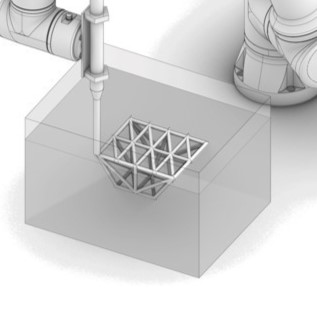Research Summary Report of A09
Injection 3D Concrete Printing (I3DCP) – Material Efficient Lightweight Reinforced Concrete Structures based on Spatially Complex Strut-and-Tie Models
[20.04.2024]
Mai, Inka, Project leader, mai@tu-berlin.de,
TU Berlin, institute of civil engineering, chair of robot assisted manufacturing of the built environment.
Main Goal
Injection 3D Concrete Printing (I3DCP) is a new additive manufacturing process where a fluid of material A is robotically injected into another fluid of another material B. The role of material B is to support material A such that material A maintains a stable position. In general, I3DCP can be categorized into sub-categories, whereby the following two subcategories are addressed within this project: Concrete in Suspension (CiS) where concrete is injected into a non-hardening carrier liquid and Concrete in Concrete (CiC) where a concrete is injected into another concrete with different properties. The main goals for these technique within this project are: i) establish a method for structural design, ii) integrate reinforcement, iii) predict and model print stability and iv) enable geometrically precise multi-strand printing.
Summary
In order to enable a successful print in Concrete in Suspension, Fig. 1, the used materials need to be well known and remain desired properties over the period of production. Therefore, currently the mixture design and rheological characterisation of i) the injected material as well as ii) the non-hardening carrier liquid are focused.
Various injected materials will be investigated. It is likely that a low thixotropic structural build-up of the injected material is desired in order to have constant boundary conditions during the print and still enable sufficient mechanical bonding of nodes when paths are crossing. The variation in the mixture composition aims at a reduced cement content and changing the rheological properties as well as its density in order to deduce failure modes during the print to certain properties.
The non-hardening carrier liquid needs to be robust as well as has to remain stable at least until the injected material is hardened. The yield stress τ0 of the carrier liquid is the parameter that must be specifically controlled in the carrier liquid and needs a minimum value to avoid sedimentation or floating of the injected material. Moreover, the yield stress is not supposed to be too high in order to prevent from nozzle deformations and unnecessary resistance during printing. Therefore, an optimal window for the duration of the print needs to be met.
Rheological properties are the key in order to understand material-process interactions, which are in turn the basis for enabling and controlling a successful print.
Current state of research
As the non-hardening carrier liquid needs to be robust as well as has to remain stable at least until the injected material is hardened, the yield stress τ0 of the carrier liquid is the parameter that must be specifically controlled in the carrier liquid. The carrier liquid is the main focus in the beginning of the project.
Currently, limestone powder suspensions varying in solid volume fraction and methyl cellulose (MC) content are investigated regarding yield stress (not shown here in detail) and sedimentation stability, Fig. 2. As expected, it is found that an increase in solid volume fraction in the limestone powder suspension (LS) from 44% to 58% is accompanied by a decrease in separated water volume, i.e. a decrease in sedimentation. For 58% even no sedimentation is observed within 180 minutes. The same behavior is observed when methyl cellulose is added to suspensions with lower solid volume fraction. Already for a suspension with 44% solid volume fraction with 1% of methyl cellulose, no sedimentation is occurring. For now it is concluded that for longer hardening times of the injected material it is favorable to choose a carrier liquid which does not sediment. Therefore, either high solid volume fractions of the suspension or the addition of additives are favorable.











